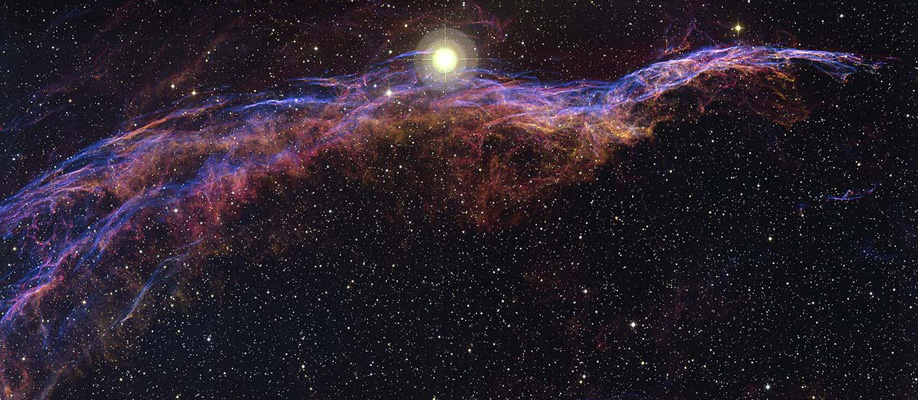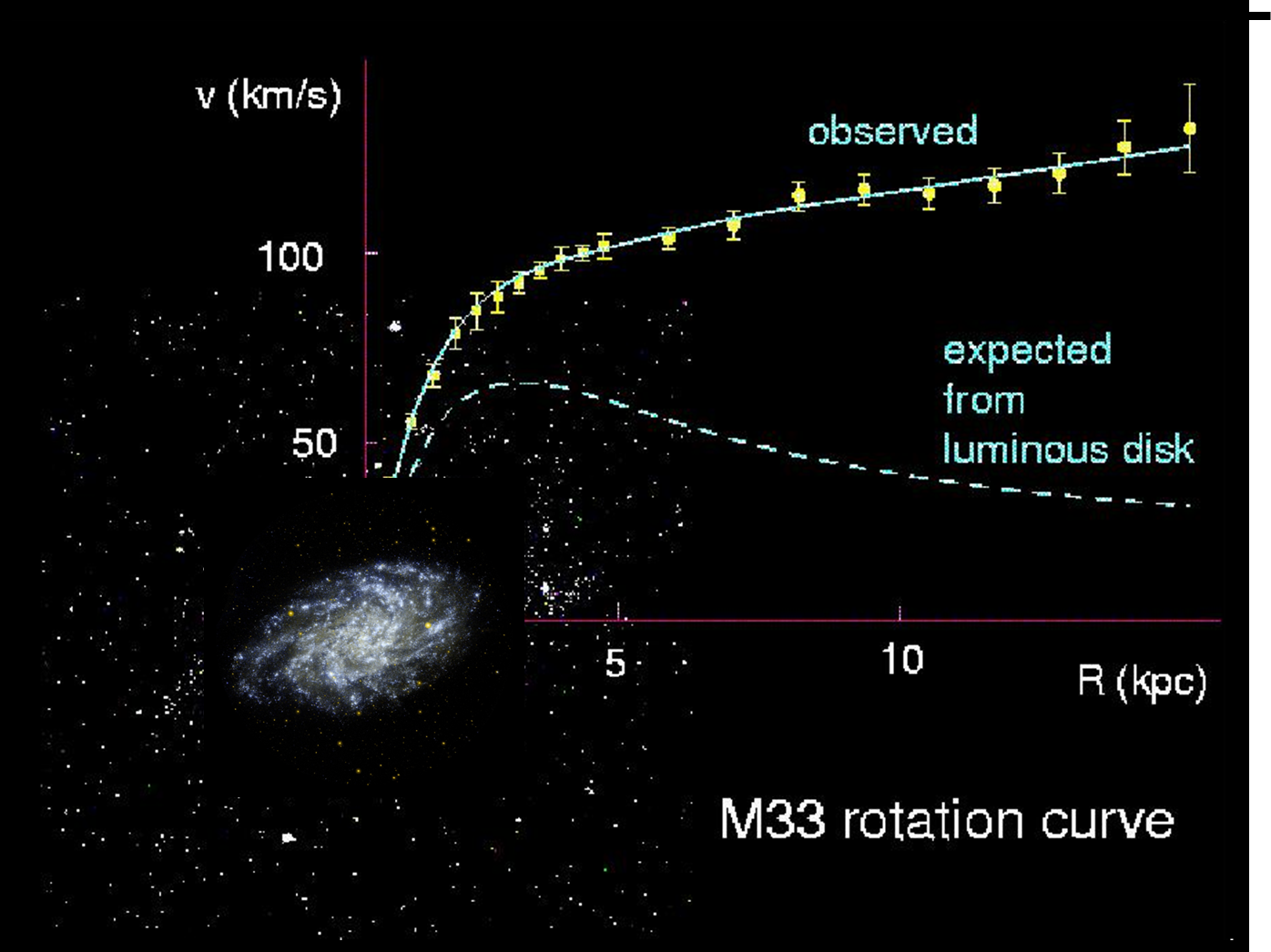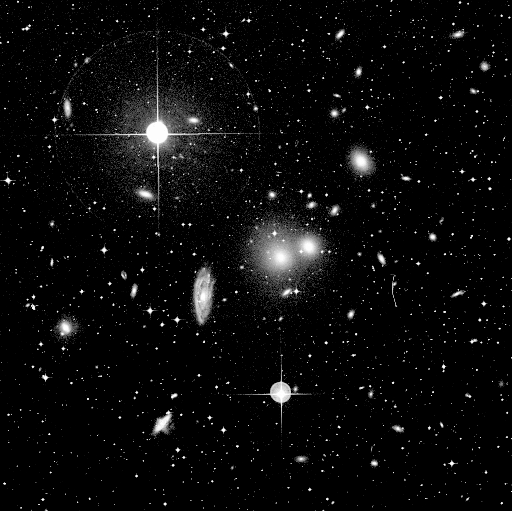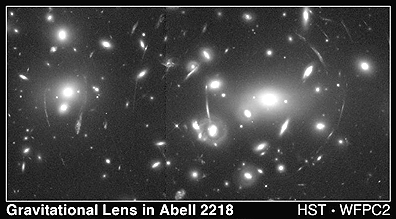Materia oscura / Dark matter
Materia oscura / Dark matter
Segnalato dal Dott. Giuseppe Cotellessa / Reported by Dr. Giuseppe Cotellessa

Che cos'è la Materia Oscura ?
Quali sono le osservazioni sperimentali che hanno portato alla formulazione del problema della Materia Oscura?
Sono state le osservazioni di stelle, galassie e ammassi di galassie da parte di astronomi e astrofisici a far nascere l’idea che l’Universo avesse molta più massa di quella visibile.
Le galassie sono costituite da un nucleo molto luminoso e massiccio attorno al quale ruotano le altre stelle, distribuite in maniera tale che la loro concentrazione diminuisce man mano che ci si allontana dal nucleo galattico (Figura 1).
Di cosa e’ fatta la Materia Oscura?
La natura della materia oscura è ancora sconosciuta. Essa può avere varie componenti: una di tipo barionico (materia "ordinaria", cioè fatta da atomi) e una, più “esotica”, di tipo non barionico.
La componente barionica, costituita da oggetti massicci ma non luminosi, può essere costituita da pianeti, nane bianche (stelle che hanno finito di bruciare), nane brune (stelle che non hanno mai cominciato a bruciare), stelle di neutroni e buchi neri.
Questi oggetti vanno sotto il nome di MACHOs (Massive Astrophysical Compact Halo Objects = Oggetti astrofisici massicci e compatti di alone) ed emettono per loro natura una quantità di luce troppo scarsa per poter essere rivelati. Esiste però un diverso sistema di rivelazione di questi oggetti, basato su un effetto detto lente gravitazionale(1).
Le osservazioni attuali indicano che la materia oscura barionica presente nell’universo può contribuire solo per una piccolissima percentuale alla Materia Oscura.
La Materia Oscura non barionica non è costituita da oggetti compatti ma da particelle non ancora scoperte. Si ipotizza che possa trattarsi di particelle supersimmetriche quali neutralini, o neutrini massicci o altre particelle mai osservate e soggette solo alla forza gravitazionale e all’interazione nucleare debole. Queste classe di particelle, note con il nome di WIMPs (Weakly Interacting Massive Particles = particelle massive debolmente interagenti), sono molto massive (100 volte più pesanti di un protone o più), ma interagiscono pochissimo con la materia.
Esse vagherebbero nel Cosmo, addensandosi in prossimità delle galassie a causa dell’attrazione gravitazionale. I fisici ritengono che le WIMPs altro non siano che delle particelle previste da alcune teorie (per esempio la supersimmetria), ma non ancora osservate neanche nei più potenti acceleratori.
E l’Energia Oscura?
Segnalato dal Dott. Giuseppe Cotellessa / Reported by Dr. Giuseppe Cotellessa

Che cos'è la Materia Oscura ?
La nascita della Materia Oscura e’ profondamente legata ai grandi progressi fatti in Cosmologia, la branca della Fisica che studia la nascita e l’evoluzione del nostro Universo. Fino alla prima metà del 1900 si credeva che la quasi totalità della massa dell'Universo risiedesse nelle stelle; oggi invece sappiamo che queste costituiscono soltanto una percentuale irrisoria della materia cosmica (circa il 4%). La restante parte della massa dell’Universo non è visibile e a tale massa mancante si dà appunto il nome di Materia Oscura.
Gli scienziati, inoltre, pensano che accanto alla Materia Oscura esista una particolare forma di energia (nota come Energia Oscura), la quale, secondo il principio di equivalenza di Einstein (E = mc2), è in grado di dar conto della maggior parte della massa dell’Universo.
Quali sono le osservazioni sperimentali che hanno portato alla formulazione del problema della Materia Oscura?
Sono state le osservazioni di stelle, galassie e ammassi di galassie da parte di astronomi e astrofisici a far nascere l’idea che l’Universo avesse molta più massa di quella visibile.
Le galassie sono costituite da un nucleo molto luminoso e massiccio attorno al quale ruotano le altre stelle, distribuite in maniera tale che la loro concentrazione diminuisce man mano che ci si allontana dal nucleo galattico (Figura 1).
 |
| Figura 1:La Galassia spirale M83. / The M83 spiral galaxy. |
Dalla legge di gravitazione universale di Newton si ricava che in un sistema gravitazionale come quello di una galassia, la velocità delle stelle che si trovano nella regione esterna al nucleo deve decrescere all’aumentare della distanza. Al contrario, le osservazioni effettuate su centinaia di galassie hanno dimostrato che la velocità delle stelle anche lontane dal nucleo era molto maggiore di quella attesa e inoltre non diminuiva con la distanza (Figura 2). Questo può essere spiegato solo se si assume che la galassia contenga della materia invisibile e non concentrata nel nucleo, la cui attrazione gravitazionale è responsabile del moto delle stelle.
 |
| Figura 2:La curva di rotazione di una galassia spirale misurata sperimentalmente. / The rotation curve of an experimentally measured spiral galaxy. |
Le galassie inoltre, sotto l’influsso della mutua interazione gravitazionale, tendono a formare degli agglomerati noti come ammassi di galassie (Figura 3). Sempre utilizzando la legge di Newton siamo in grado di determinare quale deve essere il moto relativo di ciascuna galassia di un ammasso, mediante la conoscenza della massa totale del sistema, cioè la somma delle masse delle galassie che lo compongono. Anche in questo caso, osservazioni sperimentali di un gran numero di ammassi hanno dimostrato che le velocità delle galassie erano anche 400 volte maggiori di quelle calcolate, il che indicava che l’ammasso era molto più “pesante” di quanto non sembrasse.
 |
| Figura 3:Un ammasso di galassie. / A cluster of galaxies. |
Negli ultimi anni, i risultati di diversi esperimenti hanno portato alla scoperta che il nostro Universo è piatto, ovvero che la sua curvatura spazio-temporale è nulla. Questo comporta che la densità di massa totale dell’Universo debba essere uguale a un valore noto, detto Densità Critica e pari circa a 10-30 g/cm3. La massa luminosa dell’Universo, però, non basta a dare questo valore di densità. E’ nuovamente necessario ipotizzare che la maggior parte della massa dell’Universo sia invisibile e presente sotto forme diverse dalla materia ordinaria che siamo abituati a considerare.
Di cosa e’ fatta la Materia Oscura?
La natura della materia oscura è ancora sconosciuta. Essa può avere varie componenti: una di tipo barionico (materia "ordinaria", cioè fatta da atomi) e una, più “esotica”, di tipo non barionico.
La componente barionica, costituita da oggetti massicci ma non luminosi, può essere costituita da pianeti, nane bianche (stelle che hanno finito di bruciare), nane brune (stelle che non hanno mai cominciato a bruciare), stelle di neutroni e buchi neri.
Questi oggetti vanno sotto il nome di MACHOs (Massive Astrophysical Compact Halo Objects = Oggetti astrofisici massicci e compatti di alone) ed emettono per loro natura una quantità di luce troppo scarsa per poter essere rivelati. Esiste però un diverso sistema di rivelazione di questi oggetti, basato su un effetto detto lente gravitazionale(1).
Le osservazioni attuali indicano che la materia oscura barionica presente nell’universo può contribuire solo per una piccolissima percentuale alla Materia Oscura.
La Materia Oscura non barionica non è costituita da oggetti compatti ma da particelle non ancora scoperte. Si ipotizza che possa trattarsi di particelle supersimmetriche quali neutralini, o neutrini massicci o altre particelle mai osservate e soggette solo alla forza gravitazionale e all’interazione nucleare debole. Queste classe di particelle, note con il nome di WIMPs (Weakly Interacting Massive Particles = particelle massive debolmente interagenti), sono molto massive (100 volte più pesanti di un protone o più), ma interagiscono pochissimo con la materia.
Esse vagherebbero nel Cosmo, addensandosi in prossimità delle galassie a causa dell’attrazione gravitazionale. I fisici ritengono che le WIMPs altro non siano che delle particelle previste da alcune teorie (per esempio la supersimmetria), ma non ancora osservate neanche nei più potenti acceleratori.
E l’Energia Oscura?
La cosiddetta “Energia Oscura” (Dark Energy, DE) rappresenta la componente più rilevante del nostro Universo. Secondo le più recenti osservazioni sperimentali, essa sembra costituire il 70% della densità dell’Universo.
Negli anni trenta Einstein, nel formulare la sue teoria della relatività generale, introdusse una costante, che egli stesso chiamò “costante cosmologica”. Tale quantità rappresenta in maniera semplificata l’energia che si può associare allo spazio vuoto e quindi è presente in ogni parte dell’Universo.
Einstein introdusse la costante cosmologica per fare in modo che la sua teoria descrivesse un Universo statico (come al tempo si pensava che fosse). Quando si scoprì che l’Universo era invece in espansione, egli riscrisse le sue equazioni senza la costante cosmologica, definendola “il suo più grande sbaglio”, ma senza sapere che in un futuro non troppo lontano essa sarebbe stata ripresa in considerazione.
La particolarità dell’energia oscura è che essa agisce come una gravità negativa, ovvero tende a far espandere l’Universo e si contrappone alla decelerazione dovuta all’attrazione gravitazionale della materia ordinaria e della materia oscura.
Quello dell’Energia Oscura è un campo ancora molto poco chiaro ma allo stesso tempo intrigante e studiato da un gran numero di cosmologi. Osservazioni sperimentali possono essere eseguite in maniera indiretta per determinare la concentrazione di Energia Oscura: la sua esistenza infatti, determinerebbe una accelerazione nell’espansione dell’Universo che può essere rivelata osservando sorgenti di luce molto intense e molto distanti dalla Terra, come le supernovae lontane.
Come si rivela la Materia Oscura?
La rivelazione della Materia Oscura non barionica, sotto forma di particelle (WIMPs) è estremamente difficile a causa della loro debolissima interazione con la materia.
Per poter rivelare la presenza di una particella WIMP è necessario che essa interagisca in qualche modo con il nostro strumento di misura, dando un segnale. Purtroppo queste interazioni sono molto rare (ancora più rare delle interazioni dei neutrini). Per di più il segnale che otteniamo è difficilmente distinguibile da quello di altre particelle (elettroni, fotoni e soprattutto neutroni).
Un esperimento che voglia rivelare le particelle WIMP deve essere necessariamente allestito in un laboratorio sotterraneo, dove solo particelle che interagiscono molto poco possono giungere e la presenza di altre particelle che possono disturbare le misure e costituire un rumore di fondo è ridotta al minimo.
 |
| Figura 4:Un esempio di lente gravitazionale nell'ammasso Abell 2218. / An example of a gravitational lens in the Abell 2218 cluster. |
Note:
- Lente gravitazionale: Immaginiamo che lo spazio sia come un lenzuolo esteso e ben tirato alle estremità. Se mettiamo sul lenzuolo una pallina di piombo molto pesante esso tende a deformarsi in corrispondenza del punto di contatto. Analogamente, nell’Universo, lo spazio si incurva in presenza di oggetti molto pesanti. Quando osserviamo nello spazio degli oggetti luminosi distanti da noi, le immagini di questi oggetti possono essere deviate e deformate se fra loro e noi si frappone un oggetto di massa molto elevata, come una galassia od un ammasso di galassie (Figura 4). Questo effetto, chiamato “lente gravitazionale”, avviene perché la curvatura dello spazio dovuta alla galassia o all’ammasso (la stessa che si presenta in corrispondenza della pallina di piombo) può provocare la deviazione della traiettoria della luce. Se osserviamo una sorgente luminosa e un oggetto massivo (MACHO) si frappone fra noi e la sorgente, il fenomeno a cui assistiamo è chiamato microlente (microlensing), perché la massa del MACHO non è grande abbastanza da creare una lente gravitazionale. Il fenomeno è molto simile a quello di una lente gravitazionale, solo che le varie immagini sdoppiate non sono rilevabili perché troppo vicine. Ne consegue che non potendo osservare più immagini separate, le vedremo tutte assieme, con un conseguente incremento di luminosità dell’oggetto che stiamo osservando. Questo aumento di luminosità è legato alla massa del MACHO.
ENGLISH
What is Dark Matter?
The birth of Dark Matter is deeply linked to the great progress made in Cosmology, the branch of Physics that studies the birth and evolution of our Universe. Until the first half of 1900 it was believed that almost the whole mass of the Universe resided in the stars; today, however, we know that these constitute only a negligible percentage of cosmic matter (about 4%). The remaining part of the mass of the Universe is not visible and the name of Dark Matter is given to this missing mass.
The scientists also think that alongside the Dark Matter there exists a particular form of energy (known as Dark Energy), which, according to Einstein's equivalence principle (E = mc2), is able to account for most of the mass of the Universe.
What are the experimental observations that led to the formulation of the matter of Dark Matter?
The observations of stars, galaxies and galaxy clusters by astronomers and astrophysicists gave rise to the idea that the Universe had much more mass than the visible one.
The galaxies consist of a very luminous and massive nucleus around which the other stars rotate, distributed in such a way that their concentration decreases as one moves away from the galactic nucleus (Figure 1).
According to Newton's law of universal gravitation, in a gravitational system such as that of a galaxy, the velocity of the stars in the region outside the nucleus must decrease as the distance increases. On the contrary, the observations made on hundreds of galaxies showed that the speed of the stars even far from the nucleus was much greater than the expected one and moreover it did not decrease with the distance (Figure 2). This can only be explained if we assume that the galaxy contains invisible matter and is not concentrated in the nucleus, whose gravitational attraction is responsible for the motion of the stars.
Moreover, galaxies, under the influence of the mutual gravitational interaction, tend to form agglomerations known as galaxy clusters (Figure 3). Still using Newton's law we are able to determine what the relative motion of each galaxy of a cluster must be, through the knowledge of the total mass of the system, that is the sum of the masses of the galaxies that compose it. Also in this case, experimental observations of a large number of clusters have shown that the velocities of the galaxies were also 400 times greater than those calculated, which indicated that the cluster was much "heavier" than it seemed.
In recent years, the results of several experiments have led to the discovery that our Universe is flat, that is, its space-time curvature is zero. This means that the total mass density of the Universe must be equal to a known value, called Critical Density and equal to about 10-30 g / cm3. However, the luminous mass of the Universe is not sufficient to give this density value. It is again necessary to hypothesize that most of the mass of the Universe is invisible and present in forms other than ordinary matter that we are accustomed to considering.
What is the Dark Matter made of?
The nature of dark matter is still unknown. It can have various components: one of baryonic type ("ordinary" matter, that is, made of atoms) and one, more "exotic", of non-baryonic type.
The baryonic component, consisting of massive but not luminous objects, may consist of planets, white dwarfs (stars that have finished burning), brown dwarfs (stars that have never begun to burn), neutron stars and black holes.
These objects go under the name of MACHOs (Massive Astrophysical Compact Halo Objects = massive and compact astrophysical objects of halo) and emit by their nature a quantity of light too small to be revealed. However, there is a different system of detection of these objects, based on an effect called gravitational lens (1).
Current observations indicate that the dark baryon matter present in the universe can contribute only a very small percentage to Dark Matter.
The non-baricic Dark Matter is not made up of compact objects but of undiscovered particles. It is hypothesized that these may be supersymmetric particles such as neutrinos, or massive neutrinos or other particles never observed and subject only to gravitational force and weak nuclear interaction. These class of particles, known as WIMPs (Weakly Interacting Massive Particles) are very massive (100 times heavier than a proton or more), but they interact very little with matter.
They would wander in the Cosmos, gathering close to the galaxies because of gravitational attraction. Physicists believe that WIMPs are nothing but particles predicted by some theories (for example supersymmetry), but not yet observed even in the most powerful accelerators.
And the Dark Energy?
The so-called "Dark Energy" (Dark Energy, DE) is the most important component of our Universe. According to the most recent experimental observations, it appears to constitute 70% of the density of the Universe.
In the thirties Einstein, in formulating his theory of general relativity, introduced a constant, which he himself called the "cosmological constant". This quantity represents in a simplified way the energy that can be associated to the empty space and therefore it is present in every part of the Universe.
Einstein introduced the cosmological constant to make his theory describe a static Universe (as it was once thought to be). When it was discovered that the Universe was expanding instead, he rewrote his equations without the cosmological constant, calling it "his biggest mistake", but without knowing that in the not too distant future it would be taken into consideration.
The peculiarity of dark energy is that it acts as a negative gravity, that is, it tends to expand the Universe and is opposed to the deceleration due to the gravitational attraction of ordinary matter and dark matter.
The Dark Energy field is still a very unclear field but at the same time intriguing and studied by a large number of cosmologists. Experimental observations can be performed indirectly to determine the concentration of dark energy: its existence in fact, would determine an acceleration in the expansion of the Universe that can be detected by observing very intense and very distant sources of light from the Earth, such as distant supernovae .
How does the Dark Matter reveal itself?
The revelation of the non-baryric Dark Matter in the form of particles (WIMPs) is extremely difficult because of their very weak interaction with matter.
In order to detect the presence of a WIMP particle it is necessary that it interacts in some way with our measuring instrument, giving a signal. Unfortunately, these interactions are very rare (even rarer than neutrino interactions). Moreover, the signal we obtain is hardly distinguishable from that of other particles (electrons, photons and above all neutrons).
An experiment that wants to reveal the WIMP particles must necessarily be set up in an underground laboratory, where only very little interacting particles can arrive and the presence of other particles that can disturb the measurements and constitute a background noise is reduced to a minimum.
Note:
Gravitational lens: Let's imagine that the space is like an extended and well-pulled sheet at the ends. If we put a ball of heavy lead on the sheet it tends to deform at the point of contact. Similarly, in the Universe, space curves in the presence of very heavy objects. When we observe in the space of luminous objects distant from us, the images of these objects can be deflected and deformed if an object of very high mass is interposed between them and us, like a galaxy or a cluster of galaxies (Figure 4). This effect, called "gravitational lens", occurs because the curvature of the space due to the galaxy or the cluster (the same that occurs at the lead ball) can cause the light trajectory to deviate. If we observe a light source and a massive object (MACHO) stands between us and the source, the phenomenon we are witnessing is called microlensing (microlensing), because the mass of MACHO is not large enough to create a gravitational lens. The phenomenon is very similar to that of a gravitational lens, only that the various split images are not detectable because they are too close. It follows that not being able to observe more separate images, we will see them all together, with a consequent increase in brightness of the object we are observing. This increase in brightness is related to the mass of MACHO.
Da:
https://www.lngs.infn.it/it/materia-oscura



Commenti
Posta un commento